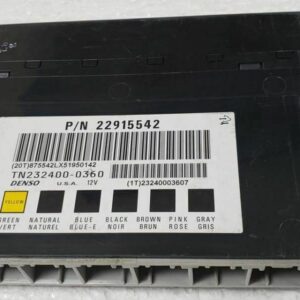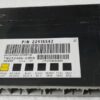Restore Your Vehicle’s Electrical System with a Pre-Programmed BCM
Are you battling bizarre electrical gremlins in your GM vehicle? Flickering dash lights, power windows with a mind of their own, or a security light that won’t turn off are classic signs of a failing Body Control Module (BCM). The BCM is the central hub for your vehicle’s comfort and convenience features, and when it malfunctions, it can cause a cascade of frustrating and confusing problems. This isn’t just an annoyance; it can affect vehicle security and safety systems. Stop chasing symptoms and replace the core component with our reliable, VIN-programmed GM Body Control Module.
We take the guesswork and dealer expense out of the equation. Simply provide your vehicle’s VIN during checkout, and our technicians will flash this module with the latest GM software specific to your car, truck, or van. It arrives at your door ready to install, saving you a trip to the dealership and hundreds in programming fees. This is the straightforward, effective solution to get your vehicle’s electronics working correctly again.
Common Signs of a Failing BCM
- ✔ Intermittent or non-functional power windows, door locks, or interior lights.
- ✔ The security or anti-theft system light stays on, potentially causing a no-start condition.
- ✔ Dashboard warning lights illuminate randomly or stay on constantly.
- ✔ Horn, wipers, or radio operate erratically or not at all.
- ✔ Diagnostic trouble codes (DTCs) related to communication errors, such as U0140, U0155, or other U-series codes, are stored in the system.
Case Study: A Tricky Diagnosis
A customer brought in their 2014 Chevy Traverse with a complaint that was driving them crazy: the instrument cluster would randomly go dark while driving, the radio would shut off, and sometimes the power liftgate wouldn’t open. They had already replaced the battery to no avail. My initial scan showed a slew of communication loss codes across multiple modules. This pointed away from a single component and toward a network issue. After checking the main data bus connectors and grounds, everything looked solid. The culprit? A failing GM Body Control Module. It was intermittently dropping off the network, causing chaos with every other module it communicated with. Installing a VIN-programmed BCM like this one solved every single issue in one go, restoring the vehicle and the owner’s peace of mind.
A Straightforward Guide to BCM Installation
- ✔ Safety First: Always disconnect the negative terminal from your vehicle’s battery before beginning any electrical work.
- ✔ Locate the BCM: On most supported models (like the Traverse, Acadia, or Impala), the BCM is located on the driver’s side of the dashboard, often behind the lower dash panel near the steering column. For vans like the Savana and Express, it’s typically found in the center dash area.
- ✔ Remove Trim Panels: Carefully remove any plastic trim or panels necessary to access the module. Use a non-marring pry tool to avoid damage.
- ✔ Disconnect and Remove: Unplug the electrical connectors from the old BCM. They have locking tabs that need to be depressed. Once disconnected, unbolt or unclip the module from its mounting bracket.
- ✔ Install the New Module: Mount the new, pre-programmed BCM in the same location and reconnect all electrical connectors, ensuring they click securely into place.
- ✔ Final Steps: Reinstall the trim panels and reconnect the negative battery terminal. Start the vehicle to verify that the main functions are restored.
Important Post-Installation Information
Because this module is central to many vehicle systems, some models may require a simple recalibration procedure after installation. Please be aware of the following possibilities:
- Airbag System Sync: If your airbag warning light is on after installation, a procedure called ‘Setup SDM Primary Key in BCM’ is needed. This syncs the new BCM with the airbag system and requires a professional-grade scan tool. This is only necessary if the light appears.
- Brake Pedal Position Relearn: On some vehicles, a brake pedal position sensor relearn may be required to ensure proper brake light operation and to prevent issues with the traction control system.
Disclaimer: Specific procedures can vary by vehicle. Always consult a factory service manual or a qualified technician for guidance.
Verified Vehicle Compatibility
This module, part number 22820314, is a direct replacement for the original and also interchanges with part number 22915542. It is guaranteed to fit the following GM vehicles:
- Acadia: 2013-2016, 2017 (Limited)
- Captiva Sport: 2013-2015
- CTS: 2014-2015 (Coupe), 2014 (SW & V-Series Sedan)
- Enclave: 2013-2017
- Express Van (1500, 2500, 3500): 2013-2018
- Impala: 2013, 2014-2016 (Limited)
- Savana Van (1500, 2500, 3500): 2013-2018
- Traverse: 2013-2017
Frequently Asked Questions
How does the programming process work?
After you place your order, you will need to provide us with your vehicle’s 17-digit VIN. Our technicians use this VIN to load the correct, factory-issued software and calibrations onto the module before it ships. This ensures it works correctly with your specific vehicle options.
Is this a difficult part for a DIYer to install?
For most individuals with basic mechanical skills, this is a very manageable job. The primary challenge is accessing the module, which may require removing a few interior trim panels. Since the module comes pre-programmed, no special computer tools are needed for the initial installation.
Do I need to send my old BCM back?
No, there is no core charge for this part. You can keep your original module.
What if the airbag light comes on after I install it?
This can happen on certain models. It means the new BCM needs to be electronically ‘introduced’ to the airbag control module (SDM). This procedure, called ‘Setup SDM Primary Key in BCM’, must be done with a professional scan tool and will resolve the light.
Will this fix my specific electrical problem?
The BCM is responsible for a wide range of body and electrical functions. If your vehicle is showing multiple, seemingly unrelated electrical symptoms as listed above, a faulty BCM is a very likely cause. Proper diagnosis is always recommended, but this part is the definitive solution for a failed BCM.



